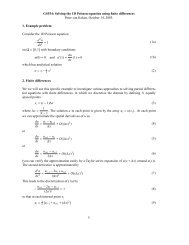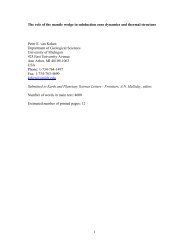Quantitative paleoenvironmental and paleoclimatic reconstruction ...
Quantitative paleoenvironmental and paleoclimatic reconstruction ...
Quantitative paleoenvironmental and paleoclimatic reconstruction ...
Create successful ePaper yourself
Turn your PDF publications into a flip-book with our unique Google optimized e-Paper software.
ARTICLE IN PRESS<br />
10 N.D. Sheldon, N.J. Tabor / Earth-Science Reviews xxx (2009) xxx–xxx<br />
depth in the profile (see below). Applications of the Ti/Al ratio include<br />
confirming similar provenance for latest Permian <strong>and</strong> earliest Triassic<br />
paleosols in a study of weathering intensity changes across the<br />
boundary (Sheldon, 2006a), to compare modern <strong>and</strong> Precambrian<br />
weathering of Vertisol-like paleosols (Driese et al., 2007), to compare<br />
provenance between different pedotypes <strong>and</strong> potential sediment<br />
source areas using Oligocene–Miocene paleosols (Hamer et al.,<br />
2007b), <strong>and</strong> to infer parent material homogeneity in Precambrian<br />
paleosols (e.g., Rye <strong>and</strong> Holl<strong>and</strong>, 2000).<br />
Fig. 6 depicts the Ti/Al ratio as a function of depth for various<br />
weakly- to moderately-developed paleosols that formed on different<br />
types of parent material. In each case, the mean parent material value<br />
is very close to the values at any position within the profile (i.e., nearly<br />
constant depth profile), <strong>and</strong> both mudstone <strong>and</strong> s<strong>and</strong>stone parents<br />
are characterized by low Ti/Al ratios. In contrast, basalt-parented<br />
paleosols show somewhat more variability with depth due typically to<br />
a minor component of ash <strong>and</strong>/or sediment, but also significantly<br />
higher Ti/Al ratios throughout the profiles. Taken together, these<br />
results suggest that the Ti/Al ratio is a reliable indicator of provenance<br />
(e.g., Stiles <strong>and</strong> Stensvold, 2008).<br />
An example of using the Ti/Al ratio to examine weathering<br />
intensity is found in Fig. 7. In contrast to the moderately developed<br />
basalt-parented paleosols results shown in Fig. 6, the paleosols in<br />
Fig. 7 show significantly reduced Ti/Al ratios in the upper part of their<br />
profiles. The paleosols in Fig. 6 are all identified as being Inceptisollike<br />
or Andisol-like (Protosol), whereas the more developed paleosols<br />
in Fig. 7 are all identified as being Alfisol-like (Argillisol). Closer<br />
inspection of the chemical data of Sheldon (2003, 2006d) indicates<br />
that both Ti <strong>and</strong> Al have been lost, but that Ti has been more extensively<br />
lost. In thin section, Ti-bearing minerals like rutile <strong>and</strong> Feoxides<br />
show minimal alteration. This suggests that the Ti loss at the<br />
top of the paleosols profiles is due to physical removal rather than<br />
chemical dissolution. That idea is further supported by the fact that<br />
the highest Ti/Al ratios are in the parental basalt. If Ti has been<br />
dissolved <strong>and</strong> transported within the profile downward into the B<br />
horizon of the paleosols, then that accumulation would result in the<br />
highest Ti/Al ratios at that level, which is not observed in any of the<br />
Fig. 6. Ti/Al ratios for moderately developed paleosols. Squares are basalt-parented<br />
Quaternary paleosols; data are from Sheldon (2006c). Diamonds are for s<strong>and</strong>stoneparented<br />
latest Permian <strong>and</strong> earliest Triassic paleosols; data are from Sheldon (2006a).<br />
Triangles are from mudstone-parented Eocene <strong>and</strong> Oligocene paleosols; data are from<br />
Sheldon et al. (2009).<br />
Fig. 7. Ti/Al ratios for well-developed paleosols on basalt. Data are from middle Miocene<br />
paleosols (Sheldon, 2003, 2006d).<br />
profiles. The primary weaknesses of this approach are with low Ti<br />
parent materials <strong>and</strong> in differentiating between chemical <strong>and</strong> physical<br />
removal of either Ti or Al during pedogenesis, though petrography/<br />
SEM studies offer a means to account for the second problem.<br />
5.2.2. Major element weathering indices<br />
The other primary use of major element geochemistry has been to<br />
identify single indices that quantify the totality of weathering processes.<br />
The first of these was proposed by Nesbitt <strong>and</strong> Young (1982)<br />
<strong>and</strong> is called the “chemical index of alteration” or CIA:<br />
CIA = 100 ×<br />
Al<br />
Al þ Ca þ K þ Na<br />
where each of the elemental concentrations is coverted to moles. The<br />
CIA is a measurement of the weathering of feldspar minerals <strong>and</strong> their<br />
hydration to form clay minerals. As clay content increases Al should<br />
also increase, whereas Ca, K, <strong>and</strong> Na contents should decrease, leading<br />
to higher CIA values. For example, a pure sample of microcline<br />
(KAlSi 3 O 8 ) would have a CIA value of 50. If it was weathered to form<br />
pure illite (which has a chemical formula similar to muscovite<br />
[KAl 3 Si 3 O 10 (OH) 2 ]), the CIA value would increase to 75. Similarly, if<br />
the illite was completely leached of K <strong>and</strong> kaolinite was formed, the<br />
CIA value would further increase up to 100. Depending on the parent<br />
material chemistry, CIA changes during weathering may be quite large<br />
or relatively small. For example, tholeiitic basalt has CIA values of 40–<br />
45 (Sheldon, 2003); the formation of Alfisol-like paleosols (Argillisols)<br />
on tholeiitic basalts of the Columbia River Flood Basalt group<br />
under temperate conditions gave rise to B horizon CIA values of 60–70<br />
(Sheldon, 2003). Parent materials that have already been cycled as<br />
sediments or which are clay-rich in the first place may start out with<br />
CIA values of 60–70, with weathering leading to even higher values. In<br />
general, the CIA is most useful for silicate rocks because a typical<br />
limestone would have very low Al levels to start with <strong>and</strong> thus, a very<br />
low CIA value that might not change appreCIAbly during pedogenesis.<br />
More recent authors (Maynard, 1992; Fedo et al., 1995) have been<br />
concerned about post-burial addition of K by metasomatism <strong>and</strong> have<br />
modified the CIA to account for metasomatism by removing K from<br />
their modified CIA expressions in different ways. A second potential<br />
issue with K arises from illitization of clay minerals (e.g., smectites) in<br />
ð5Þ<br />
Please cite this article as: Sheldon, N.D., Tabor, N.J., <strong>Quantitative</strong> <strong>paleoenvironmental</strong> <strong>and</strong> <strong>paleoclimatic</strong> <strong>reconstruction</strong> using paleosols, Earth-<br />
Science Reviews (2009), doi:10.1016/j.earscirev.2009.03.004















